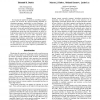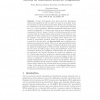98
Voted
AUSAI
2007
Springer
15 years 4 months ago
2007
Springer
Planning as satisfiability is a powerful approach to solving domain independent planning problems. In this paper, we consider a relaxed semantics for plans with parallel operator a...
PARLE
1989
15 years 4 months ago
1989
We explore an algebraic language for networks consisting of a xed number of reactive units, communicating synchronously over a xed linking structure. The language has only two ope...
102
Voted
PPSN
1992
Springer
15 years 4 months ago
1992
Springer
The limitations of linear chromosomes and conventional recombination operators are reviewed. It is argued that there are at least three classes of problems for which such represen...
104
Voted
AGENTS
1997
Springer
15 years 4 months ago
1997
Springer
Downsizing the number of operators controlling complex systems can increase the decision-making demands on remaining operators, particularly in crisis situations. An answer to thi...
135
click to vote
TES
2001
Springer
15 years 4 months ago
2001
Springer
Current developments show that tomorrow’s information systems and applications will no longer be based on monolithic architectures that encompass all the functionality. Rather, t...
89
Voted
IFIP
2009
Springer
15 years 5 months ago
2009
Springer
Trust dilution and trust fusion are two operators that are used to calculate transitive trust in a trust network. Various implementations of these operators already exist but are n...
88
Voted
HAPTICS
2003
IEEE
15 years 5 months ago
2003
IEEE
Cobots assist humans by mechanically guiding motion along software-defined paths or surfaces. Cobot design has been extensively studied previously. This paper reports the first sy...
GECCO
2004
Springer
15 years 5 months ago
2004
Springer
In evolutionary algorithms a common method for encoding neural networks is to use a tree-structured assembly procedure for constructing them. Since node operators have difficulties...
GECCO
2004
Springer
15 years 5 months ago
2004
Springer
In a series of papers [3-8], Daida et. al. highlighted the difficulties posed to Genetic Programming (GP) by the complexity of the structural search space, and attributed the probl...
104
click to vote
ICDE
2007
IEEE
15 years 6 months ago
2007
IEEE
A variety of real-world applications share the property that data arrives in form of transient streams. Data stream management systems (DSMS) provide convenient solutions to the p...





